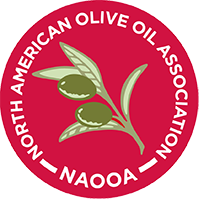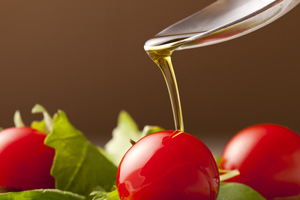Yes, You Can Cook with Olive Oil!
Did you know that you can safely cook with olive oil, and that the smoke point isn’t an issue for nearly all cooking methods? This is just one of several key points that Eryn Balch from the North American Olive Oil Association shared with us. We talked with her recently for this ONE on ONE article that features people who are part of ONE including dietitians, doctors, educators, and sponsors. Together we’re working to bring healthier food choices to everyone’s table.
Eryn Balch, executive vice president of the North American Olive Oil Association, travels the country and throughout Europe to help educate people about olive oil. Whether she’s presenting to chefs and students in culinary schools, talking one-on-one with consumers, or connecting with healthcare professionals, the message is the same – olive oil has a place in a healthy diet.
For those who are not familiar with the NAOOA, its mission is to educate consumers about the different grades of olive oil, its health benefits, and uses in the kitchen. Just as importantly, it’s committed to ensuring quality olive oil products are available in North America. Since 1989, NAOOA has participated in the International Olive Council’s (IOC) Quality Monitoring Program, collecting hundreds of samples per year from stores throughout North America. These samples are tested by IOC-certified labs around the globe for authenticity and chemical compliance with the grade level. “We want to ensure that when a shopper buys a bottle of olive oil, they know exactly what they’re buying — It’s the right type of oil for their purposes and it’s authentic,” says Eryn. “We literally will randomly take products off supermarket shelves and test them. We’re pleased to report that there is very little mislabeling of olive oil products in the U.S.”
“One way we get the word out about olive oil is through ONE and your network of healthcare professionals, and we really value this relationship,” she adds. “We encourage healthcare professionals to check out our Directory listing which provides links to a variety of resources including recipes and video tutorials, as well as my contact information – I invite them to contact me if they have questions on nutrition, types of olive oil, or anything else that they may need.”
Speaking of questions, we asked Eryn if she found a common thread in the questions she gets asked when she’s on the road. “No matter where I have the opportunity to share information about olive oil, many of the same questions and misperceptions do come up.” Of course, we had to ask what they are! She shared with us the top three; her comments follow:
Can we cook with olive oil?
Olive oil is a healthy fat to enjoy in a variety of ways from eating as a dressing on salads to roasting, sautéing and baking. “So, yes,” she tells us, “olive oil can be used for cooking. It’s a versatile ingredient that’s delicious and good for you. While it is true that the smoke point of olive oils may be lower than other cooking oils, it is still high enough for nearly all types of cooking!”
Olive oil must be green, green, green in color!
“Olive oil is a lot like wine. The color is affected by many factors including the type of olive used, where it was grown, and how the oil was produced. Excellent olive oil can vary from golden yellow to a darker shade of green and the color is not indicative of the flavor either. This is why professional olive oil tasters use blue-tinted tasting glasses – to avoid false flavor perceptions influenced by the oil’s color.”
All olive oil is the same.
“No, not exactly. There are several types of olive oil, from extra virgin olive oil to light-tasting olive oil. Each has a role to play in the kitchen. For example,
Extra virgin is not only the healthiest type but also the most versatile due to the broad range of flavor profiles you can find. It can be used in dressings or marinades or can be drizzled on practically everything!
Olive oil is a fantastic every-day cooking oil and is great for grilling, sautéing, roasting, frying and baking. It’s more subtle than EVOO so it doesn’t overwhelm a dish. It’s also a good base for spice-infused dressings and hearty sauces.
Light-tasting olive oil is almost flavorless, so you can use it for all cooking methods and it’s ideal if you don’t want to influence the flavor of any dish.”
“We have a number of experienced olive oil users sharing their knowledge at our Olive Oil Conference (www.oliveoilconference.com) July 18 – 20, 2016, Westin O’Hare, Rosemont, IL. This event is a great place for dietitians and nutritionists to get all the how-to’s on choosing and using olive oil.”
As we closed our conversation, we asked Eryn if she had any final thoughts she wanted to share with our readers. “One thing for consumers to keep in mind is that olive oil is an agricultural product and will be affected by many of the same factors as other seasonal products, such as weather conditions and supply and demand, so the price can fluctuate from year to year. But with that said, olive oil can fit into most budgets, especially if shoppers choose the right type for different uses. And remember, a little drizzle goes a long way to adding lots of flavor!”



